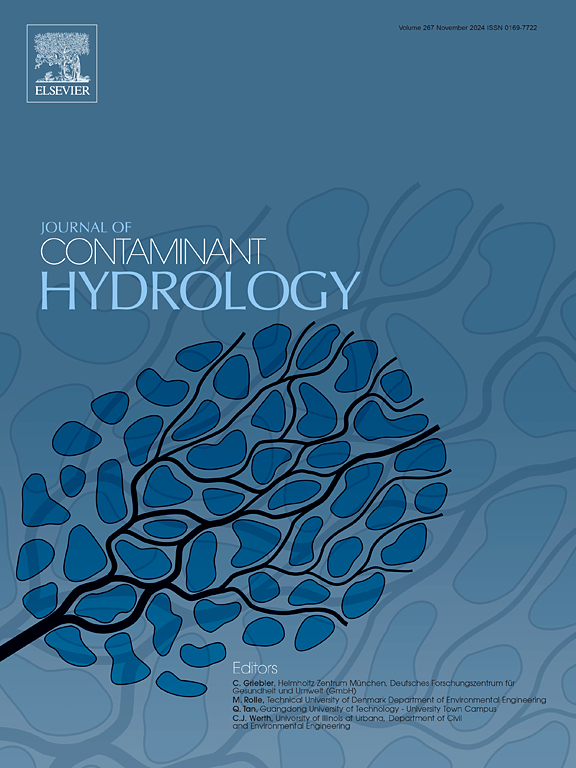利用因子分析和多元线性回归模型评估污染场地地下水水质监测数据的变异性。
IF 3.5
3区 环境科学与生态学
Q2 ENVIRONMENTAL SCIENCES
引用次数: 0
摘要
监测污染物浓度的长期趋势是必要的,以核实衰减过程有效地发生在一个地点。然而,监测数据经常受到极端变异性的影响,从而无法确定明确的浓度趋势。尽管自20世纪80年代以来人们就知道,长筛监测井的监测数据可能存在偏差,但目前在许多污染地点使用的长筛监测井的可变性更高。了解可能影响监测数据可变性的因素至关重要。为此,在采用多方法的水化学概念建模之后,在意大利北部的一家前炼油厂,对经过全面筛选的监测井进行了长达11年的碳氢化合物浓度变化评估。该方法将因子分析与多元线性回归模型相结合。结果表明,地幔柱边缘的烃浓度变异性较大,而地幔柱源和岩心的变异性较小。测量到的碳氢化合物浓度的总变异性中有44- 46%是由于“固有的羽流非均质性”,这与污染物羽流的三维结构有关,它在边缘变得更薄,在羽流边缘形成了氧化还原条件的垂直非均质性。这种变异性表现为硫酸盐浓度的增加和甲烷浓度的减少,代表了不能通过改进采样程序来降低的背景变异性。其余的56- 54%的可变性可能是由于某些净化和采样操作的非标准化,例如泵的吸入位置、净化和采样时间/流速以及分析方法的变化。这一发现表明,通过标准化所有清洗/采样操作或使用可以减少实际筛管长度的采样技术(例如封隔器或分离/双泵技术)来改善全筛井的监测,将使数据变动性降低一半以上。本文章由计算机程序翻译,如有差异,请以英文原文为准。
Assessing data variability in groundwater quality monitoring of contaminated sites through factor analysis and multiple linear regression models
Monitoring of long-term contaminant concentrations trends is essential to verify that attenuation processes are effectively occurring at a site. However, monitoring data are often affected by extreme variability which prevents the identification of clear concentration trends. The variability is higher in long-screened monitoring wells, which are currently used at many contaminated sites, although it has been known since the 1980s that monitoring data from long-screened wells can be biased. Understanding the factors that may influence the variability of monitoring data is pivotal. To this end, following hydrochemical conceptual modelling using a multi-method approach, the variability of hydrocarbon concentrations from fully screened monitoring wells was assessed over eleven years at a former oil refinery located in Northern Italy. The proposed methodology combined factor analysis with multiple linear regression models.
Results pointed out a higher variability in hydrocarbon concentrations at the plume fringe and a lower variability at the plume source and core. 44–46 % of the total variability in measured hydrocarbon concentrations is due to “intrinsic plume heterogeneity”, related to the three-dimensional structure of a contaminant plume, which becomes thinner at the edge, creating a vertical heterogeneity of redox conditions at the plume fringe. This variability, expressed as increasing concentrations of sulfate and decreasing concentrations of methane, represents a background variability that cannot be reduced by improving sampling procedures. The remaining 56–54 % of the total variability may be due to the non-standardization of some purging and sampling operations, such as pump intake position, purging and sampling time/flow rates and variations in the analytical methods. This finding suggests that monitoring improvements in fully screened wells by standardizing all purging/sampling operations or using sampling techniques that can reduce the actual screen length (e.g., packers or separation/dual pumping techniques) would reduce data variability by more than half.
求助全文
通过发布文献求助,成功后即可免费获取论文全文。
去求助
来源期刊

Journal of contaminant hydrology
环境科学-地球科学综合
CiteScore
6.80
自引率
2.80%
发文量
129
审稿时长
68 days
期刊介绍:
The Journal of Contaminant Hydrology is an international journal publishing scientific articles pertaining to the contamination of subsurface water resources. Emphasis is placed on investigations of the physical, chemical, and biological processes influencing the behavior and fate of organic and inorganic contaminants in the unsaturated (vadose) and saturated (groundwater) zones, as well as at groundwater-surface water interfaces. The ecological impacts of contaminants transported both from and to aquifers are of interest. Articles on contamination of surface water only, without a link to groundwater, are out of the scope. Broad latitude is allowed in identifying contaminants of interest, and include legacy and emerging pollutants, nutrients, nanoparticles, pathogenic microorganisms (e.g., bacteria, viruses, protozoa), microplastics, and various constituents associated with energy production (e.g., methane, carbon dioxide, hydrogen sulfide).
The journal''s scope embraces a wide range of topics including: experimental investigations of contaminant sorption, diffusion, transformation, volatilization and transport in the surface and subsurface; characterization of soil and aquifer properties only as they influence contaminant behavior; development and testing of mathematical models of contaminant behaviour; innovative techniques for restoration of contaminated sites; development of new tools or techniques for monitoring the extent of soil and groundwater contamination; transformation of contaminants in the hyporheic zone; effects of contaminants traversing the hyporheic zone on surface water and groundwater ecosystems; subsurface carbon sequestration and/or turnover; and migration of fluids associated with energy production into groundwater.
 求助内容:
求助内容: 应助结果提醒方式:
应助结果提醒方式:


